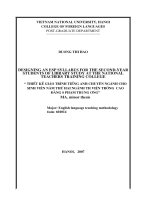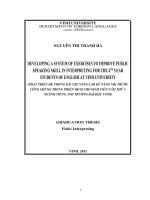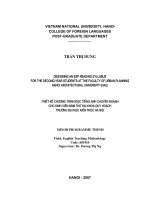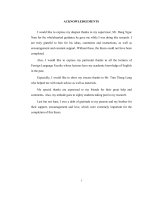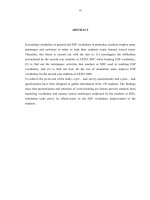Designing an ESP speaking syllabus for the second year students of business adminitration at ho chi minh university of industry
Bạn đang xem bản rút gọn của tài liệu. Xem và tải ngay bản đầy đủ của tài liệu tại đây (408.24 KB, 87 trang )
MINISTRY OF EDUCATION AND TRAINING
VINH UNIVERSITY
-----------------DANG THI HAI CHUNG
DESIGNING AN ESP SPEAKING SYLLABUS FOR THE
SECOND YEAR STUDENTS OF BUSINESS ADMINISTRATION
AT
HO CHI MINH UNIVERSITY OF INDUSTRY
THIẾT KẾ CHƯƠNG TRÌNH DẠY NĨI CHO SINH VIÊN NĂM THỨ HAI
CHUYÊN NGÀNH QUẢN TRỊ KINH DOANH, TRƯỜNG ĐẠI HỌC CƠNG
NGHIỆP THÀNH PHỐ HỒ CHÍ MINH
Master thesis in Education
Field: Theory and Methodology of English Language Teaching
Code: 60.14.10
Vinh, 2011
1
APPENDIX 1
QUESTIONNAIRE FOR THE SECOND YEAR STUDENTS OF BUSINESS
We are doing a survey about business student’s opinions concerning the essential
aspects of ESP speaking syllabus for the second year students at HUI, Nghe An
branch. The survey is expected to help us in designing an ESP speaking syllabus
appropriate to students. We sincerely appreciate your help in responding to all the
questions and items in the following parts. Please circle your choice or tick or write
your own information where applicable.
Full name: …………………………………………………………………………..
Sex: (Male/ Female)…………………………………………………………………
Age: …………………………………………………………………………………
Class: ………………………………………………………………………………..
Faculty: ……………………………………………………………………..............
Year: ………………………………………………………………………………..
Did you study English before entering University? Yes/ No: ……………………...
Your present level of English: ……………………………………………………...
How long have you been learning English at HUI? ………………………………..
Other special information you want to add: ………………………………...............
Section 1: Opinions on designing an ESP speaking syllabus for the second – year
students of Business and Administration, HUI and expectations for the ESP
2
speaking syllabus. (Please circle your choice for the following questions).
1. According to you, an ESP speaking syllabus for the second year students of
Business and Administration at HUI is:
A. very necessary and useful
B. not necessary and useful
C. no idea
2. Please rate the importance of the following objectives needed to be
achieved at the end of ESP speaking course for the second year students of
Business and Administration, HUI by putting a tick in the appropriate box.
Objectives
Very
important
1.
To express their ideas in English
2.
To communicate socially in English
3.
To communicate in business world in the future jobs
4.
To improve the general communication skills
5.
To review and consolidate the general vocabulary
Important Not
important
No
respond
and grammar
6.
To improve the specialist language knowledge in
business
Section 2: Tasks and topics needed to be included in the ESP speaking syllabus
1. Tasks
To help us to design a successful syllabus, please fill out the form below. Please rate
the importance of the tasks using English in your job by putting a tick in the
3
appropriate box.
Tasks
Very
Necessary
necessary
Not
No
Necessary
Respond
1. Contacting with clients
2. Using the phone
3. Dealing with visitors
4. Making reports to managers
5. Giving presentations
6. Participating in meetings
7. Negotiating
8. Interviewing people
9. Solving problem
2. Needed topics:
Please put a tick at the following topics/ functions you think are necessary to be
included in the syllabus.
Topics/ Functions
1. Meeting & introducing
2. Presenting a company
Your choice
Topics/ Functions
13. Entertaining/ eating out
14. Getting people to do
3. Taking part in & managing
things(offers, requests)
15. Promoting products &
a meeting
4. making a presentation
brands
16. Negotiating (reaching
agreement & dealing with
5. Telephoning: making
conflicts)
17. Dealing with visitors
contact & arrangements
6. Telephoning: exchanging
18. Interviewing people
information
4
Your choice
7. Complaining on the
19. Giving directions
telephone
8. Telephoning to make an
20. Choosing a hotel
order
9. Participating in discussions
21. Giving regulations &
advice
22. Focusing competitors
23. Doing market research
24. Making schedules
10. Describing trends
11. Presenting a product
12. problem solving
Others:
………………………………………………………………………………………………
………………………………………………………………………………………………
………………………………………………………………………………………………
Section 3: Speaking activities needed to be included in the syllabus.
Activities
Your choice
1. Cued conversations
2. Role – play
3. Prompted sentences
4. Single – word substitution
5. Games
6. Interview
7. Ordering activities
8. Class questionnaire
Activities
9. Discussion
10. Reporting
11. Problem – solving
12. Story completion
13. Information – gap activity
14. Brain storming
15. Presentation
16. Picture description
Your choice
Thank you very much for your thoughts and help.
5
APPENDIX 2
QUESTIONNAIRE FOR THE GRADUATES OF BUSINESS
We are doing a survey about business ex - student’s opinions concerning the
essential aspects of ESP speaking syllabus for the second year students at HUI,
Nghe An branch. The survey is expected to help us in designing an ESP speaking
syllabus appropriate to students. We sincerely appreciate your help in responding to
all the questions and items in the following parts. Please circle your choice or tick or
write your own information where applicable.
Section 1: Overview of the use of English in Business field
1. How important to success in your field after graduation are the following
abilities?
High
Moderate
Low
Reading
Writing
Speaking
Listening
Please specify:
………………………………………………………………………………………
………………………………………………………………………………………
………………………………………………………………………………………
6
2, How often do you have difficulty with each of these skills when you use English
in your current job?
Very often
Often
Sometimes
Rarely
Never
Reading
Writing
Speaking
Listening
Please specify:
………………………………………………………………………………………
………………………………………………………………………………………
Section 2: Tasks and topics needed to be included in the ESP speaking syllabus
1. Tasks
To help us to design a successful syllabus, please fill out the form below. Please rate
the importance of the tasks using English in your job by putting a tick in the
appropriate box.
Tasks
Very
Necessary
necessary
1. Contacting with clients
2. Using the phone
3. Dealing with visitors
4. Making reports to managers
5. Giving presentations
6. Participating in meetings
7. Negotiating
8. Interviewing people
9. Solving problem
7
Not
No
Necessary
respond
2. Needed topics:
Please put a tick at the following topics/ functions you think are necessary to be
included in the syllabus.
Topics/ Functions
1. Meeting & introducing
2. Presenting a company
Your choice
Topics/ Functions
13. Entertaining/ eating out
14. Getting people to do
3. Taking part in & managing
things(offers, requests)
15. Promoting products &
a meeting
4. making a presentation
brands
16. Negotiating (reaching
Your choice
agreement & dealing with
5. Telephoning: making
conflicts)
17. Dealing with visitors
contact & arrangements
6. Telephoning: exchanging
18. Interviewing people
information
7. Complaining on the
19. Giving directions
telephone
8. Telephoning to make an
20. Choosing a hotel
order
9. Participating in discussions
21. Giving regulations &
10. Describing trends
11. Presenting a product
12. problem solving
advice
22. Focusing competitors
23. Doing market research
24. Making schedules
Others (please specify):
………………………………………………………………………………………………
………………………………………………………………………………………………
8
………………………………………………………………………………………………
………………………………………………………………………………………………
………………………………………………………………………………………………
Thank you very much for your thoughts and help.
APPENDIX 3
QUESTIONNAIRE FOR TEACHERS OF ENGLISH
We are doing a survey about English teacher’s opinions concerning the essential
aspects of ESP speaking syllabus for the second year students at HUI, Nghe An
branch. The survey is expected to help us in designing an ESP speaking syllabus
9
appropriate to students. We sincerely appreciate your help in responding to all the
questions and items in the following parts. Please circle your choice or tick or write
your own information where applicable.
Section 1: Opinions on designing an ESP speaking syllabus for the second – year
students at the faculty of Business and Administration, HUI and expectations for the
ESP speaking syllabus. (Please circle your choice for the following questions)
1. According to you, an ESP speaking syllabus for the second year students of
Business and Administration at HUI is:
A. very necessary and useful
B. not necessary and useful
C. no idea
2. Please rate the importance of the following objectives needed to be achieved at
the end of ESP speaking course for the second year students of Business and
Administration, HUI by putting a tick in the appropriate box.
Objectives
Very
Important Not
important
10
No
important respond
1. To express their ideas in
English
2. To communicate socially in
English
3. To communicate in business
world in the future jobs
4. To improve the general
communication skills
5. To review and consolidate
the general vocabulary and
grammar
6. To improve the specialist
language
knowledge
in
business, i.e. vocabulary or
expressions in business
Section 2: Topics needed to be included in the ESP speaking syllabus
Please put a tick at the following topics/ functions you think are necessary to be
included in the syllabus.
Topics/ Functions
1. Meeting & introducing
2. Presenting a company
Your choice
Topics/ Functions
13. Entertaining/ eating out
14. Getting people to do
3. Taking part in & managing
things(offers, requests)
15. Promoting products &
a meeting
4. making a presentation
brands
16. Negotiating (reaching
11
Your choice
agreement & dealing with
5. Telephoning: making
conflicts)
17. Dealing with visitors
contact & arrangements
6. Telephoning: exchanging
18. Interviewing people
information
7. Complaining on the
19. Giving directions
telephone
8. Telephoning to make an
20. Choosing a hotel
order
9. Participating in discussions
21. Giving regulations &
10. Describing trends
11. Presenting a product
12. problem solving
advice
22. Focusing competitors
23. Doing market research
24. Making schedules
Others:
………………………………………………………………………………………………
………………………………………………………………………………………………
Section 3: Grammar and structures needed to be included in the syllabus
Please tick in the boxes the types of grammar and structures that you think
should be included in the syllabus and add more of your own if necessary
Items grammar and structures
Very
Important
Grammar-structures
1. Uses of tenses
Important
2. -ed and -ing adjectives
3. Gerunds
4. Questions
5. Relative clauses
6. Imperative
7. Adverb clauses
8. Modal verbs
9. The infinitive and the “ing” form
10. Prepositions and prepositional phrases
11. Conditional sentences
12. Passive voice
12
Not
important
13. Indirect speech
14. Comparison of adjectives
15. Plurals
Others:
………………………………………………………………………………………………
………………………………………………………………………………………………
Section 4: Speaking exercises needed to be included in the syllabus.
Activities
Your choice
1. Cued conversations
2. Role – play
3. Prompted sentences
4. Single – word substitution
5. Games
6. Interview
7. Ordering activities
8. Class questionnaire
Activities
9. Discussion
10. Reporting
11. Problem – solving
12. Story completion
13. Information – gap activity
14. Brain storming
15. Presentation
16. Picture description
Your choice
Others:
………………………………………………………………………………………………
………………………………………………………………………………………………
………………………………………………………………………………………………
Thank you very much for your thoughts and help.
TABLE OF CONTENTS
CERTIFICATE OF ORIGINALITY OF STUDY PROJECT REPORT...............................i
ACKNOWLEDGEMENTS...................................................................................................ii
ABSTRACT..........................................................................................................................iii
FIGURES AND TABLES....................................................................................................iv
TABLE OF CONTENTS.......................................................................................................1
CHAPTER 1: INTRODUCTION.......................................................................................... 4
13
.....................................................................................................................................
.....................................................................................................................................
.....................................................................................................................................
1. 1. Rationale............................................................................................................ 4
1.2 . Aims and objectives...........................................................................................5
1.3. Scope of the study...............................................................................................5
1.4. Methods of the study ............................................................................................5
1.5. Design of the study.............................................................................................6
CHAPTER 2: LITERATURE REVIEW...................................................................7
2.1. Syllabus design...................................................................................................7
2.1.1. Definition of syllabus......................................................................................7
2.1.2. Types of syllabus.............................................................................................9
2.1.2.1. Structural syllabus........................................................................................9
2.1.2.2. Notional - Functional syllabus....................................................................10
2.1.2.3. Situational Syllabuses.................................................................................13
2.1.2.4. Task-based syllabuses.................................................................................14
2.1.2.5. Topic - based syllabuses.............................................................................16
2.1.2.6. Skill – based syllabus..................................................................................18
2.1.2.7. An integrated syllabus................................................................................19
2.1.3. ESP syllabus..................................................................................................20
2.1.3.1. Definition of ESP........................................................................................20
2.1.3.2. Types of ESP..............................................................................................23
2.2. Approaches to syllabus design in ESP..............................................................25
2.2.1. Language - centered approach.......................................................................25
2.2.2. Skills- centered approach...............................................................................25
2.2.3. Learning- centered approach..........................................................................26
2.3. Needs analysis in ESP......................................................................................27
2.3.1. What are needs?.............................................................................................27
2.3.2. Needs analysis...............................................................................................28
14
2.3.3. The purposes of needs analysis......................................................................30
2.3.4. Procedures for conducting needs analysis......................................................32
CHAPTER 3: NEEDS ANALYSIS.....................................................................................35
3.1. Introduction......................................................................................................35
3.2. Situation analysis..............................................................................................35
3.2.1. Institutional factors........................................................................................35
3.2.2. Teacher factors..............................................................................................36
3.2.3. Learner factors...............................................................................................37
3.2.4. A brief look at English teaching and learning at HUI, Nghe An Campus......38
3.3. The study..........................................................................................................40
3.3.1. The subjects...................................................................................................40
3.3.2. The instruments of data collection.................................................................40
3.4. The findings......................................................................................................41
3.4.1 Needs perceived by the second year students .................................................................41
3.4.1.1. Students’ opinions on designing an ESP speaking syllabus..........................41
3.4.1.2. Needed topics perceived by the students ....................................................................43
3.4.1.3. Needs perceived by the students’ choice of speaking skills and exercises............45
3.4.2. Needs perceived by the graduates of Business........................................................46
3.4.2.1. The graduates’ overview of the use of English in Business field................46
3.4.2.2. Needed topics perceived by the graduates.................................................................47
3.4.3. Needs perceived by the teachers of the English section.................................................50
3.4.3.1. ESP teachers’ opinions on designing an ESP speaking syllabus...................50
3.4.3.2. Needed topics perceived by the ESP teachers .............................................................52
3.4.3.3. Needs perceived by the teachers’ choice of grammatical structures..........................53
3.4.3.4. Needs perceived by the teachers’ choice of speaking activities.........................54
3.5. Summary............................................................................................................ 55
CHAPTER 4: A PROPOSED ESP SPEAKING SYLLABUS FOR THE SECOND YEAR
STUDENTS OF BUSINESS ADMINISTRATION AT HUI.................................................56
15
4.1. Special characteristics of the ESP speaking course................................................56
4.2. The aims and objectives of the ESP speaking course........................................58
4.3. The selection of content in the speaking syllabus...................................................59
4.4. Speaking activities employed in the speaking syllabus...........................................60
4.5. Grammar and structures.......................................................................................61
4.6. Sequence of the syllabus......................................................................................61
4.7. Time allocation...................................................................................................62
4.8. The proposed speaking syllabus for the second year students of Business and
Administration at HUI...............................................................................................63
4.9. Evaluation..........................................................................................................63
4.9.1. Oral testing......................................................................................................63
4.9.2. Test techniques.................................................................................................64
4.9.3. Sample speaking tests.......................................................................................65
4.9.4. Marking...........................................................................................................66
CHAPTER 5: CONCLUSION...............................................................................................69
5.1. A summary and guidelines on application.............................................................69
5.2. Limitation and recommendations for further research............................................70
REFERENCES.........................................................................................................72
APPENDICES
Appendix 1: A student questionnaire
Appendix 2: A questionnaire for the graduates of Business
Appendix 3: A questionnaire for the teachers of English
Appendix 4: A suggested speaking syllabus for the second year students of Business
Administration at HUI
CHAPTER 1: INTRODUCTION
1. 1. Rationale
English is the most spoken official language in the world and the primary
language of global trade and commerce. It is an international means of interaction
and communication in almost all the countries. Moreover, the role of English has
16
become more increasingly important in an increasingly interconnected and
globalized world. It is actual state of Vietnam and other countries in the process of
integration into international economy. The career opportunities will come to the
graduate who can use English properly. Hence, to get ready for the job in the future,
learning English to communicate is very necessary for students.
Ho Chi Minh City University of Industry (HUI) attaches special importance
to offer the foreign language to the students, especially students of Business and
Administration, the businessmen in the future. Our students are expected to speak
English well so as to use English as a means of international communication.
However, students have coped with a lot of difficulties in speaking English because
of following reasons. Firstly, their English level is low and they lack speaking skills
which they weren’t taught at high school. They make a lot of mistakes when they
participate in conversations. Hence, they find hard to give an oral presentation and
get involved in discussions in English. Secondly, there is a problem of syllabus
design at HUI. There have not been ESP syllabuses in general and ESP speaking
syllabus in particular. The university chooses Market leader, Intermediate, by
David Cotton, David Falvey and Simon Kent to use. Such kind of material seems to
be difficult for the students who have never learnt Business English before. Also,
some topics are not relevant to students’ needs. Moreover, speaking skill has not
been focused and students have few opportunities to practice speaking English. It
leads to the fact that the students’ speaking ability is very poor.
The shortage of an appropriate syllabus for the second year students of
Business and Administration at the HUI is a big and urgent question, waiting to be
answered. And it is of great necessity and significance to both teachers who are
teaching ESP and students of business. Being a teacher taking charge of teaching
Business English for the second year students of Business Administration, I am
fully aware of the importance of improving student’s skill and I am interested in the
topic designing an ESP syllabus for them. This is the reason why the topic
“Designing an ESP speaking syllabus for the second year students of Business and
Administration at HUI” is the subject matter chosen for my thesis. Hopefully, the
17
study, to which I will devote all my efforts, will make a contribution to the English
teaching and learning of the teachers and students at HUI.
1.2. Aims and objectives
The study aims at designing an appropriate ESP syllabus for the second year
students of Business and Administration at the HUI
To achieve this aim, three objectives are set to be obtained.
To develop a theoretical framework related to an ESP syllabus design.
To conduct a Needs Analysis to identify the students’ learning situation, the
learning needs perceived by the teachers who are responsible for the ESP course
and the second year students of Business.
To propose an appropriate ESP syllabus for the target students based on the
relevant theories and the Needs Analysis.
1.3. Scope of the study
This study is initiated and developed from the urgent need to design an effective
ESP syllabus for second year students of Business at HUI. Due to the general
institutional academic situation, priority is given to speaking skill. The author of the
study is concerned with the second year students of Business and Administration,
English teachers at HUI, Nghe An branch and business graduates of HUI. Other
approaches to syllabus designs intended for students and other subjects at any other
levels of English language proficiency would be beyond the scope.
1.4. Methods of the study
In this study, both quantitative and qualitative methods are used. These involve the
following tasks:
Collecting and analyzing data about the needs of the learners, teachers and the
existing syllabus at HUI.
Discussing the result from: questionnaires, discussion and observation.
Describing in detail the content of the speaking syllabus for the second year
students of Business and Administration at HUI.
1.5 Design of the study
18
The study will consist of the following parts:
Chapter 1: INTRODUCTION
This chapter is devoted to the rationale, the scope, the aims and objectives,
the method and the organization of the study.
Chapter 2: LITERATURE REVIEW
This part will also provide the literature of English for Specific Purposes
(ESP) and syllabus design.
Chapter 3: NEEDS ANALYSIS
This part presents the analysis of the target needs and present needs. The
chapter demonstrates that there is a need to design a speaking syllabus for the
second year students of Business Administration at HUI.
Chapter 4: A SUGGESTED ESP SPEAKING SYLLABUS FOR THE SECOND
YEAR STUDENTS OF BUSINESS ADMINISTRATION AT HUI
The part suggests the speaking syllabus in details as well as the criteria for
the syllabus design and evaluation.
Chapter 5: CONCLUSION
Main points and contents of the study will be summarized based on the
results of the study. The summary of the study, limitations and the recommendation
for further research will be presented.
CHAPTER 2: LITERATURE REVIEW
2.1. Syllabus design
2.1.1. Definition of syllabus
19
The notion of “syllabus” has been defined differently by various writers. In
defining syllabus there are several conflicting views on the distinction between
syllabus design and curriculum development.
According to Allen (1984: 49) “Syllabus ... is concerned with a specification
of what units will be taught” (as distinction from how they will be taught, which is
a matter of methodology). Nunan (1988) shares the same view: “A syllabus is a
statement of content which is used as the basic for planning courses of various
kinds. So the task of the syllabus designer is to select and grade the content.”
Approvingly, Hutchinson & Waters (1987: 80) state that ‘A syllabus is a
document which says what will (or at least what should) be learned’. However, they
examine syllabus related to the context of ESP teaching. Evaluation, organization,
materials, teacher, classroom and the learners are considered as important factors
affecting the process of designing syllabus.
Furthermore, as suggested by Jack C. Richards (2001), “A syllabus is a
specification of the content of a course of instruction and lists what will be taught
and test”. Consequently, to design a speaking syllabus relevant to the learners, the
teacher have to specify the content in terms of functions, skills, topics and their
order in the course as well as oral evaluation.
Another definition belonging to the broad view was given by Dubin and
Olshtain (1986: 28): “Whatever it is called, it is a document, which ideally
described:
What the learners are expected to know at the end of the course, or the
course objectives in operational terms.
What is to be taught or learned during the course, in the form of an inventory
of items.
When it is to be taught, and at what rate of progress, relating the inventory of
items to the different levels and stages as well as the time constraints of the course.
How it is to be taught, suggesting procedures, techniques, and materials.
How it is to be evaluated, suggesting testing and evaluating mechanism.”
20
